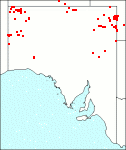Family: Poaceae
Triodia basedowii
Citation:
E. Pritzel, Reprium nov. Spec. Regni veg. 15:356 (1918).
Synonymy: T. pungens sensu J. Black, FI.S. Aust. 74 (1922), non R. Br.
Common name: Lobed spinifex, hard spinifex.
Description:
Tussocks pyramidal and sometimes becoming annular or crescentic owing to the death of the older culms in the centre; leaf blades glabrous, at least 10 cm long, the sheaths woolly-tomentose especially around the orifice, becoming glabrous with age.
Panicle exserted, 8-12 cm long, 1-2 cm broad, the branches 1-2 cm long, with very few spikelets; spikelets 6-8-flowered, ovate or oblong, 10-12 mm long; glumes 6-8 mm long, 7-1 l-nerved; lemmas 6-8 mm long, villous near the base, the 3-nerved scarious lobes as long as the horny body, the 2 lateral ones broad, obtuse or acute and glabrous except for the marginal cilia, the central one acute or subobtuse and rather longer.
Published illustration:
Williams (1980) Native plants of Queensland, p. 275; Lazarides (1970) The grasses of Central Australia, pl. 60a.
|
|
Distribution:
|
Characteristic especially of sandy regions.
S.Aust.: NW, LE, NU, FR. W.Aust.; N.T.; Qld; N.S.W.
|
Conservation status:
native
Flowering time: appears to be throughout the year.
|

SA Distribution Map based
on current data relating to
specimens held in the
State Herbarium of South Australia
|
Biology:
Described by Lazarides (1970) as "undoubtedly the most common grass in Central Australia".
Author:
Not yet available
|

